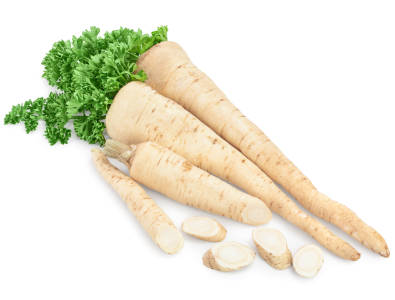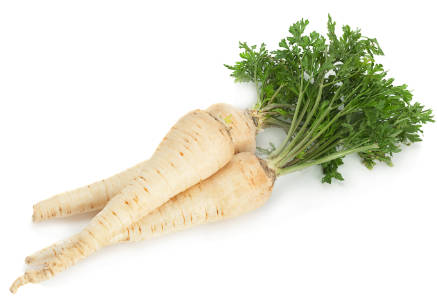Roots Category

Root vegetables are rich in nutrients, low in fat and calories, inexpensive and usually available throughout the year.
Beyond that, they have wildly varying characteristics. Radishes are pungent, carrots sweet, beets earthy. Others, like parsnips, turnips, and rutabagas, have more subtle flavors.
Root vegetables will last awhile in your pantry, and even longer in your refrigerator.
Varieties:
beet
Beets have a distinctive earthy flavor that's enhanced by roasting, but they can also be steamed, microwaved, or boiled. A beet will be more flavorful and colorful if you leave the peel and some of the stem on while it's cooking. After it's cooled down, the peel comes off fairly easily. Varieties include the familiar red beets, golden beets, which turn a golden orange when cooked and are slightly sweeter than red beets, white beets, and chioggia (pronounced KYAHD-dja) = candy-stripe beets = candy cane beets which have alternating white and red rings inside. Baby beets are sweeter and faster-cooking than larger beets. Select beets that are heavy for their size. Canned beets are a good substitute for fresh.
Learn moreblack radish
These large, pungent radishes are better known in Eastern Europe than in the United States. With their black peels and white interiors, they can be fashioned into attractive garnishes, or you can peel and cook them like turnips. You can also serve them raw, though it helps to tame them down first by salting and rinsing them.
Learn moreblack salsify
When cooked, black salsify has the taste and texture of an artichoke heart. There are two types: salsify (white salsify) and the more highly regarded black salsify. After peeling black salsify, put it into acidulated water right away to prevent it from turning brown. Canned black salsify is a good substitute for fresh, but it's hard to find.
Learn moreburdock
Burdock is becoming increasingly popular in the United States, but it's already an important vegetable in Asia. It lends an interesting, earthy flavor to soups, stews, or stir-fried dishes. Select small, firm roots.
Learn morecarrot
Raw or cooked, carrots add sweetness and color to stews, soups, stir-fries, slaws, cakes, and crudité platters, plus they're a great source of Vitamin A. Try to buy them with the greens still attached, they're usually fresher and sweeter that way.
Learn moreceleriac
This underrated vegetable is a relative of celery that's been developed for its root, which has a pleasant celery flavor. It's popular in France and Northern Europe, where it's usually peeled and cooked in stews or grated and served raw. Many large supermarkets carry celeriac; select smallish roots that are heavy for their size.
Learn morecoriander root
Thai recipes sometimes call for these roots, but they're hard to find in markets. The best source is to pull out a cilantro plant in your garden, or you can use cilantro stems instead.
Learn moredaikon
Daikon is larger and milder than its relative, the red radish. The Japanese like to grate it and serve it with sushi or sashimi, but you can also pickle it, stir-fry it, or slice it into salads. Japanese daikons tend to be longer and skinnier than their Chinese counterparts, but the two varieties can be used interchangeably. Choose specimens that are firm and shiny. They don't store well, so try to use them right away.
Learn morehorseradish
This is a very pungent brown root that's usually peeled and grated to make a condiment for meats. Its intense flavor and aroma dissipate quickly when exposed to air, so it should be grated just before serving or mixed with something sour (like vinegar, lemon juice, or beet juice) to lock in the heat. It's easiest to use a blender or food processor to grate it. Fresh horseradish is surprisingly potent, so make sure your kitchen is well ventilated, wear rubber gloves, and don't rub your eyes.
Learn morelotus root
Slices of the lotus root have a beautiful pattern. The fresh version is available sporadically; if not, the canned version is almost as good. Rinse and drain before using. Look for it in Asian markets.
Learn moreparsley root
This is hard to find in the United States, but it's a popular root vegetable in Central Europe. For more information, see the Wegman's Food Market's page on Parsley Root.
Learn moreparsnip
These are like carrots, except that they're cream-colored and never served raw. Northern Europeans like to add them to stews, but they can also be puréed or served as a side dish. Choose small, crisp ones.
Learn moreradish
With their crisp texture and peppery flavor, raw radishes are great in salads and on crudité platters. They can also be cut into attractive garnishes. Select firm, fresh-looking radishes and store them in your refrigerator for no more than a week.
Learn morerutabaga
Rutabagas look like turnips, only they're a bit larger and have a yellow complexion. Use them just as you would turnips.
Learn moresalsify
When cooked, salsify has the taste and texture of an artichoke heart. There are two types: white salsify (pictured at left) and the more highly regarded black salsify = scorzonera = black oyster plant = viper grass. After peeling salsify, put it into acidulated water right away to prevent it from turning brown. Canned salsify is a good substitute for fresh, but it's hard to find.
Learn moreturnip
Turnips can be roasted, boiled, steamed, or stir-fried. Select small turnips that feel heavy for their size.
Learn more

















































































































































































































































































































































